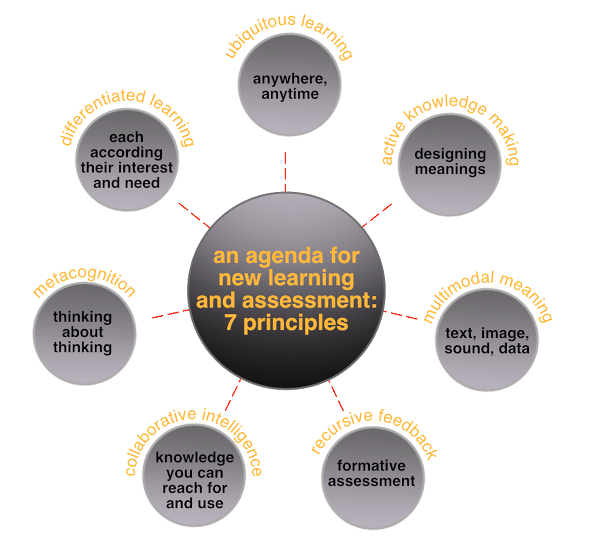What Is Ubiquitous Learning?
Ubiquitous learning (uLearning) is an eLearning ecology that focuses on creating flexible environments that learners can enter whenever and however they want. People don't necessarily have to attend physical classes or sit in front of their laptops but instead use their smartphones and tablets to participate in learning experiences. This learning method incorporates various technological tools and formats, including multimedia and interactive elements that boost engagement. Additionally, accessibility is fostered in an already flexible learning model, which makes it easy for learners to comprehend information from anywhere they are, at their convenience. Learners are not passive but can instead manage the knowledge they receive at their own pace and schedule. Digital skills are required, but even if some participants lack them, they can always ask for help from other learners or tutors on their preferred devices.
The Key Characteristics Of This Learning Ecology
Unlimited Accessibility
The only requirement of uLearning is an internet connection. It doesn't matter where you are, what time it is, or what device you use. You can access the information provided and break free from the traditional barriers of location and time. Additionally, people with disabilities can benefit from this learning ecology since assistive technologies are usually compatible with learning solutions for those with hearing or visual impairments and other learning difficulties. Lastly, uLearning is ideal for educational facilities that hand out devices to students so they can access information and courses regardless of time and space.
Social Learning And Collaboration
According to social learning theory, people tend to learn after they observe, imitate, and model the behaviors of others. This happens when learners look at others' actions and their results, either through direct social interactions or through media. Ubiquitous learning offers environments where participants can communicate with other learners, ask questions, share ideas and skills, and receive real-time feedback. Many learning platforms offer group chats, forums, social networks, and blogs for individuals to contact one another. As a result, collaboration is fostered, and a sense of collective learning is built. This benefit is immense since digital learning often makes learners feel lonely and unsupported. Therefore, people don't have to rely solely on their efforts to learn; they can learn from others' knowledge and mistakes.
Adaptability
The content in ubiquitous learning adapts to all learners' profiles, regardless of their needs and preferences. Also, tutors can customize and personalize the material and its delivery based on someone's specific requirements. Learners don't have to wait long for answers to their questions or documentation since this method is immediate in showing results and offering assistance. If an organization wants to test its adaptability, it can use the adaptability quotient (AQ) to measure how well its learning platforms react to changes and challenges. It can experiment with different solutions, including beta versions of learning platforms and prototypes, to decide which serves its learners' objectives.
Gamification And Interactivity
uLearning encourages and focuses on the implementation of interactive elements, including gamification. For example, knowledge games can be created to challenge participants to answer correctly as many questions as possible to earn badges or medals. A leaderboard may also be added so people can indulge in a little friendly competition with other participants or themselves. Additionally, Augmented Reality (AR) may be utilized to create a lifelike learning environment where everyone can meet their collaborators and tutors. They get a sense of participating in a real learning environment and communicating with collaborators like they would in a traditional classroom. Consequently, their engagement levels rise, their comprehension of the material improves, and the retention rate increases.
The Advantages Of Ubiquitous Learning
Continuous and active learning is the first and most important benefit of eLearning. It provides autonomy to learners and the freedom to access learning material whenever it is convenient for them. By being able to communicate at all times with fellow learners, participants improve their social skills and feel confident asking for help and collaborating with others. Also, they are encouraged to enforce their critical thinking and do further research to enrich their already acquired knowledge. Research is necessary to examine the trustworthiness of the sources provided. Then, they can apply that knowledge practically and check how much they've benefited.
The Challenges Of Ubiquitous Learning
For such an autonomous learning environment to work, learners must be mature enough to recognize reliable sources and not trust non-factual information. Also, being on a device while learning can pose a threat to some learners' concentration since they may easily be distracted by other web pages or applications. However, the most crucial challenge is detecting and preventing plagiarism. Cheating may be a lot easier when there is no real-time supervision. That's why curating a proctoring plan may be necessary to ensure online supervision and fair evaluation.
The 4 Learning Types
While uLearning offers more freedom than any other learning method, it cannot single-handedly solve the issue of unwilling and passive learners. Some individuals willingly seek knowledge on their own, while others are forced to participate in courses. The first category of learners is those who are both willing and active. These people don't wait for anyone to prompt them to attain knowledge and have an inner flame pushing them to learn. On the other hand, some learners are willing but passive. While they want to learn, they require someone's push to initiate the learning process. They are quite different from those who are unwilling and active. These people don't have a yearning for learning but know they must invest time in it. For instance, it can be a student who studies only because they need to pass the exam. Lastly, individuals may be both unwilling and passive.
Conclusion
Ubiquitous learning can completely alter the way education and eLearning are facilitated. With the possible integration of AI tools, learners can personalize their experiences based on their weaknesses and strengths. Also, the Internet of Things (IoT) could be used for real-time access to resources. For instance, sensors in a lab could send data straight to learners' phones. This way, knowledge is transferred without delays, and individuals can finish projects and tasks in half the time. uLearning plays a vital role in the future of learning thanks to the flexibility and adaptability it offers, and more organizations should consider adopting its principles.









